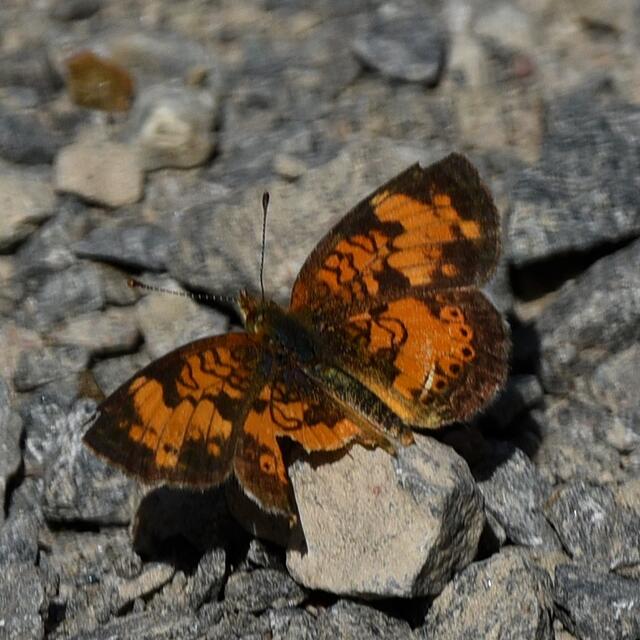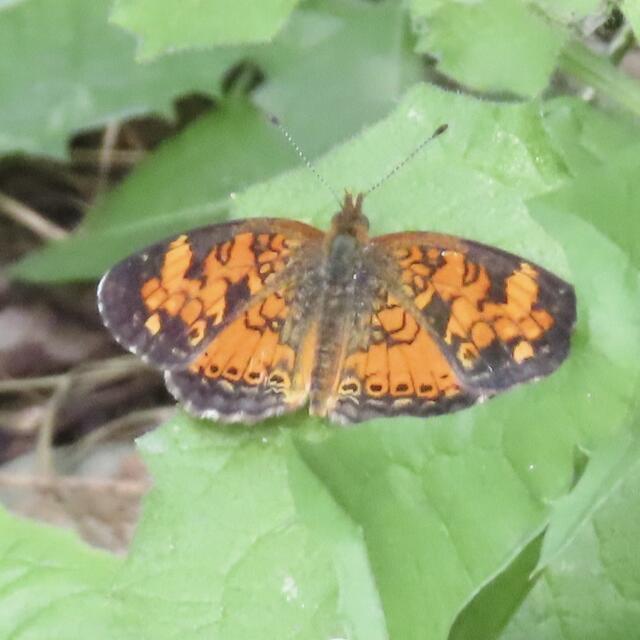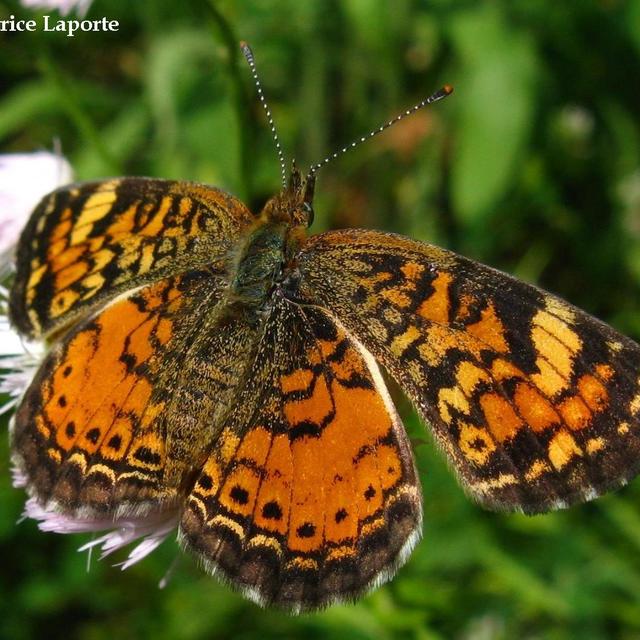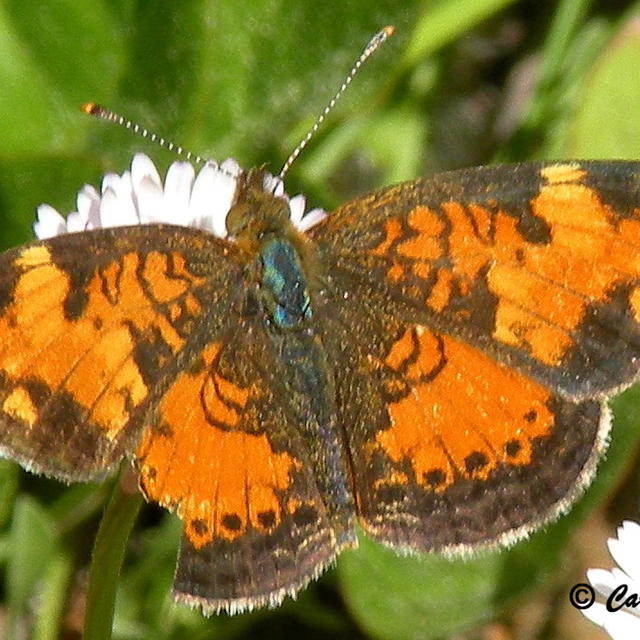Northern Crescent
Phyciodes cocyta (Cramer, 1777)
Family: Nymphalidae
Subfamily: Nymphalinae
Identification: Antennal clubs of male are orange. Females are darker than males. Upperside is orange-brown with dark borders; median orange-brown areas are mostly open, with few dark markings. Underside of hindwing is orange with a tan patch surrounding the pale marginal crescent.
Wing Span: 1 1/4 - 1 7/8 inches (3.2 - 4.8 cm).
Life History: All day long, males patrol near the host plants for receptive females. Eggs are laid in bunches of about 40 on the underside of host plant leaves. Caterpillars eat leaves, and young ones live and feed communally. Third-stage caterpillars hibernate.
Flight: One brood from June-July, perhaps two broods in southern Canada.
Caterpillar Hosts: Asters, in the sunflower family (Asteraceae).
Adult Food: Nectar from flowers of dogbane, fleabane, and white clover.
Habitat: Moist open areas in rocky places, wooded streams, marsh edges, and shale barrens.
Range: Newfoundland and northern New England west across the Great Lake states and southern Canada to British Columbia; south in the western mountains to Utah, southeast Arizona, and southern New Mexico; south in the Appalachians to Pennsylvania, Virginia, and West Virginia.
Conservation: Some geographically restricted subspecies and unnamed populations should be monitored, managed, or preserved.
NCGR:
Management Needs: Maintain habitat integrity, host plant colonies, and nectar sources.
Please donate!
We depend on donations to keep Butterflies and Moths of North America freely available. We want to express our gratitude to all who showed their support by making a contribution this year. You can donate to support this project at any time.
Advertise with us!
Do you have a product or service that you think would interest BAMONA users? If you would like to advertise on this website, contact us by email, or use the contact form and select the "Advertising" category.
Verified Sightings
Displaying 1 - 24 of 1744 verified sightings

Observation date: Jun 17, 2018
Submitted by: gearry
Region: Lincoln County, Maine, United States
Verified by: John Calhoun
Verified date: Dec 21, 2025

Observation date: Aug 23, 2025
Submitted by: Bob Jacobson
Region: Chippewa County, Wisconsin, United States
Verified by: jmgesell
Verified date: Dec 16, 2025

Observation date: Aug 23, 2025
Submitted by: Bob Jacobson
Region: Chippewa County, Wisconsin, United States
Verified by: jmgesell
Verified date: Dec 16, 2025

Observation date: Aug 23, 2025
Submitted by: Bob Jacobson
Region: Chippewa County, Wisconsin, United States
Verified by: jmgesell
Verified date: Dec 16, 2025

Observation date: Sep 07, 2025
Submitted by: Bob Jacobson
Region: Chippewa County, Wisconsin, United States
Verified by: jmgesell
Verified date: Dec 16, 2025

Observation date: Jun 24, 2025
Submitted by: voriig
Region: Quebec, Canada
Verified by: jmgesell
Verified date: Nov 24, 2025

Observation date: Jun 18, 2020
Submitted by: blgreco
Region: Mineral County, Colorado, United States
Verified by: mikefisher
Verified date: Oct 26, 2025

Observation date: Jun 25, 2007
Submitted by: hank4044
Region: Lake County, Montana, United States
Verified by: J_Martineau
Verified date: Oct 17, 2025

Observation date: Oct 11, 2025
Submitted by: drmarc60223
Region: La Crosse County, Wisconsin, United States
Verified by: jmgesell
Verified date: Oct 12, 2025

Observation date: Sep 15, 2025
Submitted by: John Terpstra
Region: Ontario, Canada
Verified by: jmgesell
Verified date: Sep 18, 2025

Observation date: Aug 24, 2025
Submitted by: henryr10
Region: Hamilton County, Ohio, United States
Verified by: rogerdowner
Verified date: Sep 02, 2025

Observation date: Jul 05, 2025
Submitted by: pgrew1@unl.edu
Region: Penobscot County, Maine, United States
Verified by: John Calhoun
Verified date: Aug 31, 2025

Observation date: Aug 02, 2025
Submitted by: dnight30
Region: Carroll County, New Hampshire, United States
Verified by: John Calhoun
Verified date: Aug 17, 2025

Observation date: Aug 03, 2025
Submitted by: TJ in Derry
Region: Rockingham County, New Hampshire, United States
Verified by: John Calhoun
Verified date: Aug 05, 2025

Observation date: Jul 27, 2025
Submitted by: cp2023
Region: Ozaukee County, Wisconsin, United States
Verified by: jmgesell
Verified date: Jul 27, 2025

Observation date: Jul 18, 2025
Submitted by: DebraRade
Region: Lake County, Illinois, United States
Verified by: rogerdowner
Verified date: Jul 26, 2025

Observation date: Jul 12, 2025
Submitted by: jrmbutterfly
Region: British Columbia, Canada
Verified by: James Steen
Verified date: Jul 17, 2025

Observation date: Jul 11, 2025
Submitted by: Cascade Colors
Region: Grand County, Colorado, United States
Verified by: mikefisher
Verified date: Jul 13, 2025

Observation date: Jul 06, 2025
Submitted by: Keylime Cat
Region: Alberta, Canada
Verified by: James Steen
Verified date: Jul 06, 2025

Observation date: Jun 30, 2025
Submitted by: Cascade Colors
Region: Grand County, Colorado, United States
Verified by: mikefisher
Verified date: Jul 06, 2025

Observation date: Jul 01, 2025
Submitted by: Razzlefish
Region: Ontario, Canada
Verified by: jmgesell
Verified date: Jul 02, 2025

Observation date: Jun 18, 2025
Submitted by: BMcNaught
Region: Susquehanna County, Pennsylvania, United States
Verified by: davidwright
Verified date: Jul 01, 2025

Observation date: Jun 25, 2025
Submitted by: barthsm
Region: Erie County, New York, United States
Verified by: jmgesell
Verified date: Jun 28, 2025

Observation date: Jun 25, 2025
Submitted by: John Terpstra
Region: Ontario, Canada
Verified by: jmgesell
Verified date: Jun 27, 2025
- 1 of 73
- next ›
















